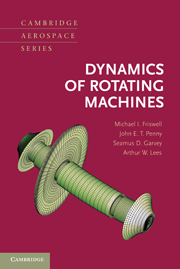Book contents
- Frontmatter
- Contents
- Preface
- Acronyms
- 1 Introduction
- 2 Introduction to Vibration Analysis
- 3 Free Lateral Response of Simple Rotor Models
- 4 Finite Element Modeling
- 5 Free Lateral Response of Complex Systems
- 6 Forced Lateral Response and Critical Speeds
- 7 Asymmetric Rotors and Other Sources of Instability
- 8 Balancing
- 9 Axial and Torsional Vibration
- 10 More Complex Rotordynamic Models
- Solutions to Problems
- Appendix 1 Properties of Solids
- Appendix 2 Stiffness and Mass Coefficients for Certain Beam Systems
- Appendix 3 Torsional Constants for Shaft Sections
- Bibliography
- Index
4 - Finite Element Modeling
Published online by Cambridge University Press: 05 February 2015
- Frontmatter
- Contents
- Preface
- Acronyms
- 1 Introduction
- 2 Introduction to Vibration Analysis
- 3 Free Lateral Response of Simple Rotor Models
- 4 Finite Element Modeling
- 5 Free Lateral Response of Complex Systems
- 6 Forced Lateral Response and Critical Speeds
- 7 Asymmetric Rotors and Other Sources of Instability
- 8 Balancing
- 9 Axial and Torsional Vibration
- 10 More Complex Rotordynamic Models
- Solutions to Problems
- Appendix 1 Properties of Solids
- Appendix 2 Stiffness and Mass Coefficients for Certain Beam Systems
- Appendix 3 Torsional Constants for Shaft Sections
- Bibliography
- Index
Summary
Introduction
The finite element method (FEM) has developed into a sophisticated method for the analysis of stress, vibration, heat flow, and many other phenomena. Although the method is powerful, its derivation is simple and logical. It is undoubtedly the combination of mathematical versatility with a simple geometric interpretation that led to the immense popularity of the method across wide areas of engineering and science. The texts by Bickford (1994), Cook et al. (2001), Fagan (1992), Irons and Ahmad (1980), and Zienkiewicz et al. (2005) provide details of the formulation of element matrices for various structural element types (e.g., beams, plates, shells, and continua). The National Agency for Finite Element Methods and Standards (NAFEMS, 1986) produced A Finite Element Primer, which is an excellent introduction to finite element (FE) methodology. This chapter explains the principles of FEA as they relate to vibrating structures. The same principles apply to the FE modeling and analysis of rotating machines.
Two alternative methods produce the equations of motion of a system. The concept of generalized coordinates is explained in Section 4.2. The forces and moments produced by elastic deformation based on changes in these coordinates are calculated. For small deflections, these forces and moments, collectively called generalized forces, are linear functions of the generalized coordinates. Newton's second law is then used to equate the rate of change of momentum in the system to the forces on the system, both from the elastic deformation and externally applied forces, as in Chapter 2.
- Type
- Chapter
- Information
- Dynamics of Rotating Machines , pp. 124 - 154Publisher: Cambridge University PressPrint publication year: 2010
- 2
- Cited by

